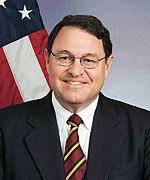NTIA CSMAC Meeting

Your blogger attended today’s Commerce Spectrum Management Advisory Committee at NTIA. (Oddly, there was an administrative screwup that fouled some peoples’ moods: the Federal Register notice specified a 9:30 start time, while the agenda published just before the meeting stated 9 AM.) Kudos at least to NTIA for quickly getting this committee up and operating. By contrast, FCC asked for nominations for its dormant Technological Advisory Council (TAC) on April 8, 2009 and again on August 31, 2009 and still hasn’t formed the committee. It is now almost 4 years since the TAC held its last meeting on July 20, 2006!
Let me also say how impressed I was that Assistant Secretary Larry Strickling was present for almost the entire meeting. This was an impressive show of interest at the top on spectrum management issues that one rarely sees at FCC.
(During the TAC’s lifetime, the FCC Chairman and commissioners only made cameo appearances at TAC meetings. Disney CTO Bran Ferren resigned from the TAC in 2000 because of the lack of high level interest. He told me that he was on another committee on high tech matters for the SEC and they routinely met with the SEC Chairman. Hence he felt FCC was not then serious about the TAC.)
I didn’t see any FCC staff I recognized other than Julius Knapp who gave a NBP presentation and then left for another meeting. But someone pointed out that WTB staffers were present. There was a presentation on “Radar 101” that had been requested by the committee members by Rick Reaser of Raytheon. Apparently they sought a presentation from NTIA staff on the issue but a squabble within NTIA resulted in a deadlock so a CSMAC member who is active in radar issues gave it. While it was correct in what it said, it oddly left out some key spectrum policy issues:
-Most radars rotate or at least have a rotating highly focused beam.
-Radars need high bandwidth since distance and target velocity resolution increase with signal bandwidth
-Radar wavelength must be small compared to the target size in order to get a significant reflection, thus radars looking for cruise missiles need higher frequencies than those looking for large bombers
It was disappointing that these issues were not included.
A general impression was that the member present generally represent large vested spectrum users, the “haves”, or military industrial complex members out to protect the spectrum of their customers. In the draft subcommittee report on spectrum inventory there was the following text:
“We respectfully suggest that the fundamental precept of redistribution needs to be challenged, and that while an audit may offer small short-term results, it cannot have significant impact on the long-term need for spectrum.”
There was considerable discussion of this sentence at the public meeting and it will be changed in the final version. But it was odd that it made it into the draft distributed at the meeting, perhaps showing how the membership is committed to the status quo.
On the issue of harmful interference, I suspect the membership didn’t want anything to happen that might affect their own interests and seemed again to opt for the status quo. From the draft subcommittee report on interference and dynamic spectrum access chaired by MSTV president David Donovan:
As a general matter, the NTIA, FCC and other spectrum managing agencies have sought to avoid “harmful” interference. Differing terms such as “disruptive interference” or “destructive interference”are sometimes employed. As a legal construct, they all involve the balancing of interests, where the potential service loss is balanced against the benefits of providing a new service. Often this analysis involves an assessment of predictive models based on probabilistic reception and interference analysis...Because of the different policy concerns and definitions of “harmful interference, the subcommittee makes no judgment as to the appropriate legal definition.
Did the subcommittee realize that “harmful interference is more than a quaint phrase, but a legal test that is used in Title III of the Communications Act in five different places? (47 U.S.C. §§301(a)(1), 303(g), 309(j)(16)(C), 337, 922)
As the IEEE-USA letter to NTIA and FCC said, lack of progress on clarifying what is “harmful interference” will probably lead to any spectrum inventory resulting in a large number of harmful interference adjudications as drawn out and difficult as the Northpoint and AWS-3 proceedings. (Recall, that there is no controversy that AWS-3 is vacant, but there is a huge unresolved argument on whether TDD in AWS-3 would result in inevitable harmful interference to the lower adjacent licensee - generally T-Mobile.)
While the draft says that probabilistic models are “often” used, this is actually a major point of contention in AWS-3 and other proceedings. Repeatedly parties have asked that the worst case “minimum coupling loss” model be used. Indeed, NTIA usually argues that this is necessary to protect federal systems. Thus the IEEE-USA letter urges a general statement on when probabilistic models are appropriate.
Finally on the inventory itself, there is little interest in actually measuring federal spectrum use as opposed to sorting existing records. There is no mention in the draft report about “US&P”/nationwide assignments that many federal agencies have. Indeed, FCC has several VHF/UHF mobile US&P assignments from NTIA for its own internal use. Absent some sort of monitoring or an audit by a disinterested party, how does one know which federal assignments are actually used or at least are being held back for some credible contingency?
I will post here the links to the final subcommittee reports when they are published in a week or two.




![Validate my RSS feed [Valid RSS]](valid-rss-rogers.png)

